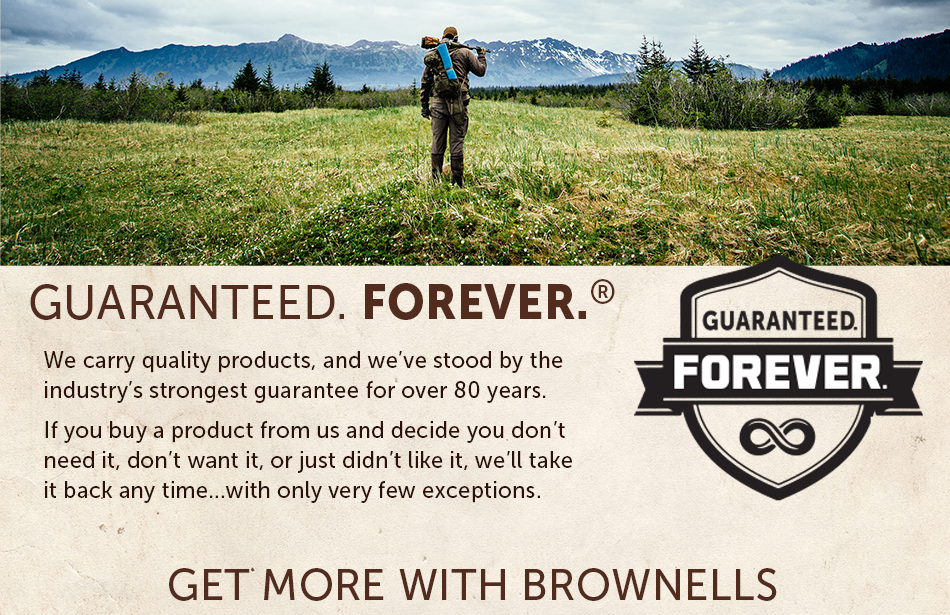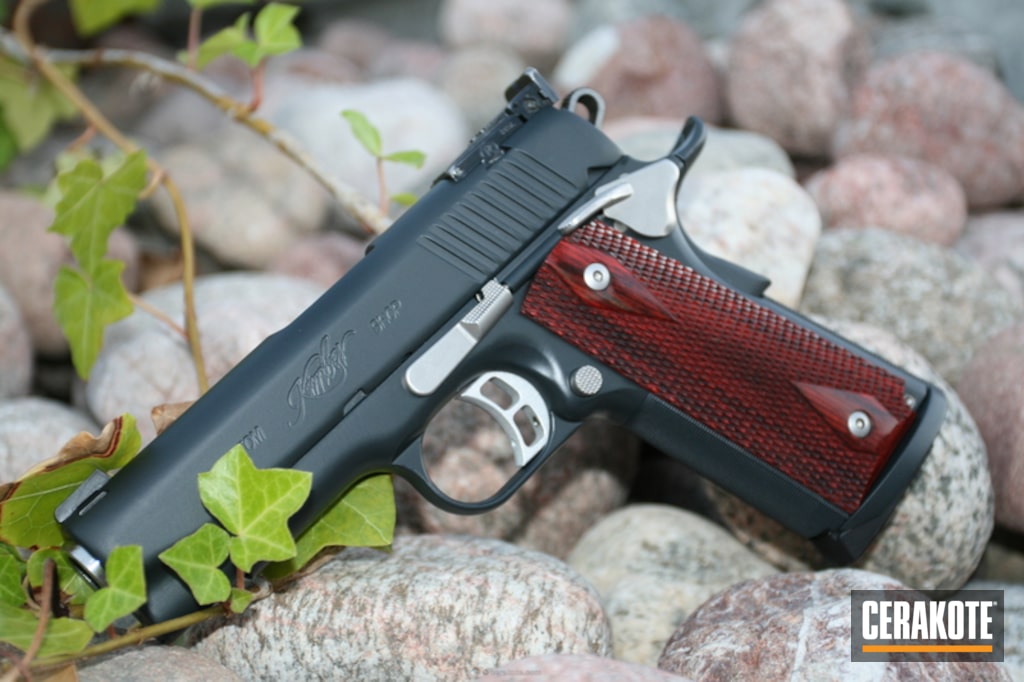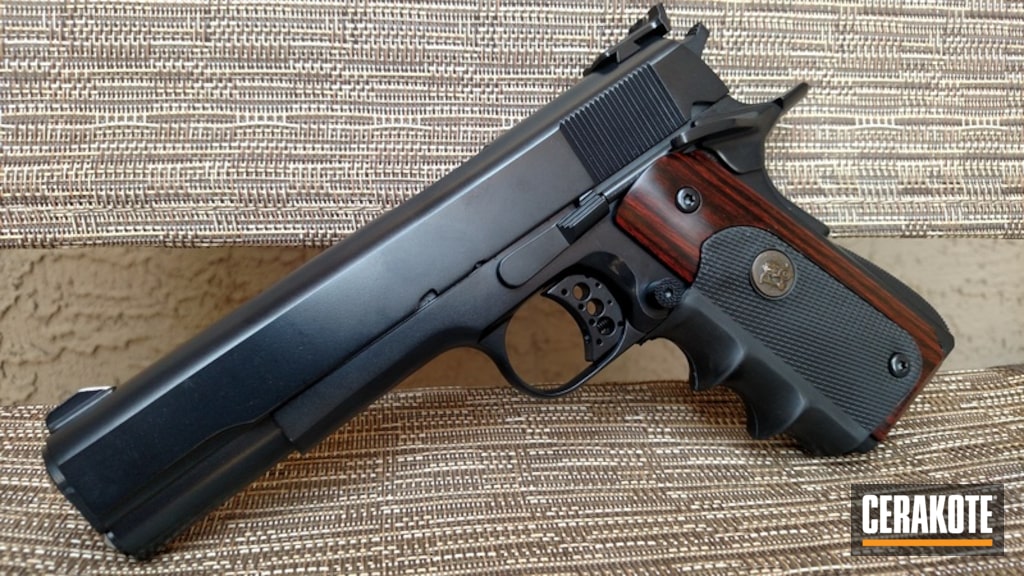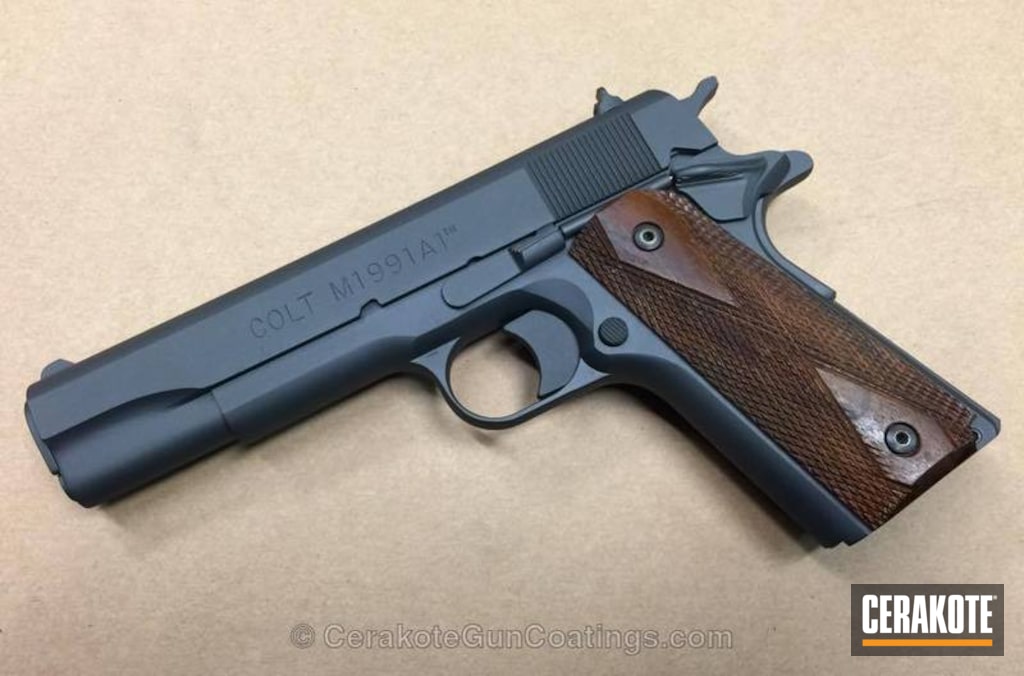I’m looking to do a cold bluing on a firearm, and am looking for a product that will give a blueish color (as opposed to black/charcoal gray). Specifically I’m trying to achieve the Colt “royal blue” finish. Does anyone know of a product that will get me there?

Cold bluing that is “blue”?
tcpip95
Discussion starter
819 posts
·
Joined 2012
- Add to quote
I’m looking to do a cold bluing on a firearm, and am looking for a product that will give a blueish color (as opposed to black/charcoal gray). Specifically I’m trying to achieve the Colt “royal blue” finish. Does anyone know of a product that will get me there?
370 posts
·
Joined 2015
Nope. Those finishes where all about surface prep as much as they where about the product.
One alternative is DLC coating. But you have to send off for that. It’s pricy but tuff as nails. If you want a royal blue you will need to do the elbow grease work first. And lots of it. Then slow rust blue has been the closest I have been able to get to it. But my test have been on small 2 inch cubes of carbon steel to practice with. Not ready for a full gun yet.
One alternative is DLC coating. But you have to send off for that. It’s pricy but tuff as nails. If you want a royal blue you will need to do the elbow grease work first. And lots of it. Then slow rust blue has been the closest I have been able to get to it. But my test have been on small 2 inch cubes of carbon steel to practice with. Not ready for a full gun yet.
6,211 posts
·
Joined 2020
Yeah. All the cold bluing is either copper sulfate (iirc), or like Oxpho Blue, which is a nice oxide.
You'll either need to ship it out or deal with Rust Blue.
You'll either need to ship it out or deal with Rust Blue.
91,370 posts
·
Joined 2000
Rust blue is the only thing you can apply at home that will even come close..... and even then it won't. Cold blues are all very poor choices for a complete refinish, as they do not give a uniform finish and wear off very easily just from handling. I consider cold blue useful for touching up nicks and scratches, and that's it.
6,211 posts
·
Joined 2020
I've used most of the cold-blues. They suck. Seriously... Best-case is Oxpho, and it won't wear as well as actual bluing, (although it isn't unattractive).
Nope. Clean it all up and rust-blue it.. It's like a one-day project at this time of year.. Two days is even easier.
Nope. Clean it all up and rust-blue it.. It's like a one-day project at this time of year.. Two days is even easier.
2,902 posts
·
Joined 2015
Best I've found-repeated applications and buffing lightly with very fine steel wool and then coat with 3in1 oil and let "cure" overnight.
![Image]()
1,248 posts
·
Joined 2022
There is a youtube video about doing blakish cold bluing that is really warm bluing. Heating it with a plumber torch, then doing the rust browning first, then oxpho blue later, heating with a torch before applying each coat.
I tried it for my son's surplus Czeck Mauser, that was all silver on all exposed metal. It was the right price for me, and will make an old trashed firearm look better for a cheap price, but it will not look like professional bluing. And the browning then bluing, produces mixed results, some produce a deep thick black that you would want, other produce blackish streaks over brown/black, looks a lot like oil rubbed bronze, which for an antique firearm doesn't really look so bad.
Cold Bluing is for touch up, or in some cases like mine, you want to make a trashed firearm look better than before without spending the money on a true professional bluing.
Before
![Image]()
Some of the parts done, unfinished on the left, finished on the right, note in the closeup the difference in hue and color between the parts...
![Image]()
The final result, the photos do it more justice than it deserves, close up you can tell the bluing is inconsistent and less than the best Black/Blue finish you would ant, but for cheap it looks a lot better than it did before....
![Image]()
![Image]()
And yes, I wore gloves most of the time, but it got in the way of the little pieces and took them off bluing the little pieces, so you can see, it doesn't take much to dye your fingers blue for several days....
And yes, I also reconditioned the wood as best I could in my amateur way, like the metal, it looks better than it did before, but short of a professional job....
You sound like a you want a very specific color of bluing and you're not going to get that with DIY home cold bluing, your going to get a blue/black color, that is inconsistent and will be different hues and shades on different parts, it will only look slightly better looking that a trashed firearm that the old bluing has faded/rubbed off.
I tried it for my son's surplus Czeck Mauser, that was all silver on all exposed metal. It was the right price for me, and will make an old trashed firearm look better for a cheap price, but it will not look like professional bluing. And the browning then bluing, produces mixed results, some produce a deep thick black that you would want, other produce blackish streaks over brown/black, looks a lot like oil rubbed bronze, which for an antique firearm doesn't really look so bad.
Cold Bluing is for touch up, or in some cases like mine, you want to make a trashed firearm look better than before without spending the money on a true professional bluing.
Before
Some of the parts done, unfinished on the left, finished on the right, note in the closeup the difference in hue and color between the parts...
The final result, the photos do it more justice than it deserves, close up you can tell the bluing is inconsistent and less than the best Black/Blue finish you would ant, but for cheap it looks a lot better than it did before....
And yes, I wore gloves most of the time, but it got in the way of the little pieces and took them off bluing the little pieces, so you can see, it doesn't take much to dye your fingers blue for several days....
And yes, I also reconditioned the wood as best I could in my amateur way, like the metal, it looks better than it did before, but short of a professional job....
You sound like a you want a very specific color of bluing and you're not going to get that with DIY home cold bluing, your going to get a blue/black color, that is inconsistent and will be different hues and shades on different parts, it will only look slightly better looking that a trashed firearm that the old bluing has faded/rubbed off.
6,211 posts
·
Joined 2020
Yes, I've refinished entire rifles (and shotguns) with Oxpho. And, yes: it always, ALWAYS works better with a heatgun or torch on hand. And, yeah: OP is not going to find a "blue", it's different shades/tints of black.
Perhaps when he uses Cyanide Bluing it will be "blue".
Perhaps when he uses Cyanide Bluing it will be "blue".
1,248 posts
·
Joined 2022
My theory, the difference pieces of the firearms are going to be different alloys, even if its the same alloy, there will be differences in the proportions in the alloys as well as different finishing processes that make for a difference in the surface and its metallurgy at the surface.
And with Cold blue, even using a torch, the best you can hope for is a thin chemical reaction with the surface of the metal. That chemical reaction is going to be different with the different metals and with a coat so thin, it will have different hues and shades.
So with cold blue, you're asking if you can get a very specific shade or hue of blue/black, buddy, you're not even going to the same shade shade of blue/black between the different pieces, let alone a very specific hue/shade of blue/black over the entire firearm.
Cold blue is for touch-up or a cheap job on a thrashed firearm to make it look better, not even close to new....
And with Cold blue, even using a torch, the best you can hope for is a thin chemical reaction with the surface of the metal. That chemical reaction is going to be different with the different metals and with a coat so thin, it will have different hues and shades.
So with cold blue, you're asking if you can get a very specific shade or hue of blue/black, buddy, you're not even going to the same shade shade of blue/black between the different pieces, let alone a very specific hue/shade of blue/black over the entire firearm.
Cold blue is for touch-up or a cheap job on a thrashed firearm to make it look better, not even close to new....
6,211 posts
·
Joined 2020
Amusingly, I checked on the "spare FEG" last week.. The one I sanded and wooled and rust-blued.
Looks to me like that finish is even darker now, a year later, beneath the wax I applied before casing it in the cupboard. Yes, the pitting is still noticeable, but man - that rust-blue really took.. To every part. Not a hint of the old pit-causing rust to be found anywhere.
OP: rust-blue for the win. (I not only have the other bottle unopened, the one I DID open is nearly full). A little goes a long, long, long-long long way.
Looks to me like that finish is even darker now, a year later, beneath the wax I applied before casing it in the cupboard. Yes, the pitting is still noticeable, but man - that rust-blue really took.. To every part. Not a hint of the old pit-causing rust to be found anywhere.
OP: rust-blue for the win. (I not only have the other bottle unopened, the one I DID open is nearly full). A little goes a long, long, long-long long way.
1,248 posts
·
Joined 2022
What's the different between Cold Bluing and Rust Bluing?
I thought all bluing was some sort of controlled rusting reaction? But there are different methods that use different chemicals.
I found this on Brownell's website

 www.brownells.com
www.brownells.com
I thought all bluing was some sort of controlled rusting reaction? But there are different methods that use different chemicals.
I found this on Brownell's website

CLASSIC AMERICAN RUST BLUE | Brownells
This solution is a favorite of custom builder Phil Pilkington who developed it to produce a deep, rich, rust blue that's so fitting when restoring older guns and on high grade, custom shotguns and rifles. No damp cabinet or special equipment requi...
1,248 posts
·
Joined 2022
Just checked the Mauser, that was all either oxpho blue or several coasts of cold brown than cold oxpho blue. 9 months later it looks the same, no darkening. So clearly, with this type of cold bluing, the reaction ends after the initial treatment and doesn't continue to react and darken over time.
So I'm interested in the Rust Bluing you're talking about and considering if I should have gone that route?
OP, sorry to hi-jack the thread, but we are still on the same subject that hopefully is helping you learn.
Only thing I'd add, you need to decide, what you want and is it worth it. If you want a very specific color of bluing and finish and its worth it, get it professionally done. If you want to DIY, then keep searching for what's best and the best way to do it, but lower your expectations, you're going to get something that looks better, not exactly what you want.
So I'm interested in the Rust Bluing you're talking about and considering if I should have gone that route?
OP, sorry to hi-jack the thread, but we are still on the same subject that hopefully is helping you learn.
Only thing I'd add, you need to decide, what you want and is it worth it. If you want a very specific color of bluing and finish and its worth it, get it professionally done. If you want to DIY, then keep searching for what's best and the best way to do it, but lower your expectations, you're going to get something that looks better, not exactly what you want.
6,211 posts
·
Joined 2020
Cold blue is just a chemical that darkens on metal. Oxpho is an oxide, pretty durable, but it's "thin" and somewhat fragile.. Bopping thru the woods with an Oxpho'd gun will scratch it up lightly.
Rust Blue is literally a rust (oxide) inducing acid mix. It "bites" the metal.
When I did the FEG, I boiled the stripped parts in vinegar to remove the old, funky blue. Rinsed in hot water. degreased with dawn/hot-water, acetone, and then 90% Isopropyl.
I left the oven on "warm" and left a sheet-tray inside, so I'd dry & warm (preheat) the parts there, hang right over the sink and apply blue, and walk away awhile.. Come back, card and boil/rinse the carding off, pop in the oven and repeat cycle. (Use distilled water for the bluing cycle, cuz otherwise you are dealing with whatever minerals and such are in the tapwater)
Eventually, after some hours, I had enough "fun" and tossed the blued, carded, rinsed, warmed, DRY parts into a qt of 30w I'd added ground charcoal into. Left it outside overnight and cleaned up the place..
Next day I washed it all with dawn and hot water again, warmed in the oven, and hit it with Johnson's paste wax. After they all cooled to the touch, I wiped off any extraneous wax and reassembled with gun oil where required.
Rust Blue is literally a rust (oxide) inducing acid mix. It "bites" the metal.
When I did the FEG, I boiled the stripped parts in vinegar to remove the old, funky blue. Rinsed in hot water. degreased with dawn/hot-water, acetone, and then 90% Isopropyl.
I left the oven on "warm" and left a sheet-tray inside, so I'd dry & warm (preheat) the parts there, hang right over the sink and apply blue, and walk away awhile.. Come back, card and boil/rinse the carding off, pop in the oven and repeat cycle. (Use distilled water for the bluing cycle, cuz otherwise you are dealing with whatever minerals and such are in the tapwater)
EDIT: iirc, the order is wrong above: you apply it, let it work, BOIL it to turn it black and then card.. Whatever.. worked great. Instructions | Rust Blue
Eventually, after some hours, I had enough "fun" and tossed the blued, carded, rinsed, warmed, DRY parts into a qt of 30w I'd added ground charcoal into. Left it outside overnight and cleaned up the place..
Next day I washed it all with dawn and hot water again, warmed in the oven, and hit it with Johnson's paste wax. After they all cooled to the touch, I wiped off any extraneous wax and reassembled with gun oil where required.
1,248 posts
·
Joined 2022
Well I think the Cold Blue is still chemically reacting with the metal....Cold blue is just a chemical that darkens on metal.....
....Rust Blue is literally a rust (oxide) inducing acid mix. It "bites" the metal.....
But I think the difference is, and you really hit on it with "bites" the metal is the type of reaction that is going on.....
Cold blue is just reacting with the surface, only a molecule or two down, and then its a new chemical laying on the surface that can be scraped off.....
Rust Blue is "etching" the surface, its eating into it and below it, so the reaction and what is left to coat is much deeper and thicker, as well, probably intermixed and interlocked with the surface and not just laying on it....
So I'm envisioning the Rust Bluing is acting more like rust than the cold blue. Rust eats into the metal surface not just reacts on the surface of the first layer of molecules, or at least eventually. The proverbial light surface rust that can be wiped off with a rag is probably when you catch the rust soon enough its only eaten down a molecule or two into the surface, kind of like how the cold blue works, just chemically reacting with the surface...
So I'm thinking Cold Blue vs Rust Blue, think Rust Blue "bites" into the surface or "etches" the surface to go deep into it....
91,370 posts
·
Joined 2000
I tried completely cold-bluing a handgun twice. The first time was with a WW1 1911 using Perma Blue and the second a Colt 1908 using Oxpho Blue. Both times the finish quickly rubbed off the front and back straps leaving a grey patina underneath. The stuff simply isn't durable enough for anything more than scratch repair.
1,248 posts
·
Joined 2022
Have you considered Cerakote?
A cold bluing or even a DIY rust bluing would be cheaper, because you're going to need sandblasting, spray gun, air compressor and the Cerakote supplies that are not cheap.
But Cerakote services are taking off everywhere and I wouldn't be surprised if you can find a professional cerakoter easier and cheaper than a professional bluing job.
Judging from what folks say, Cerakote is probably going to be more durable than a DIY cold bluing.
I see lots of folks swear that a professional bluing or parkerizing will be more durable than Cerakote, but I have a parkerized 1911 and an OEM cerakoted slide on my XD-M, both the same amount of use and the typical rub marks are showing on the 1911 Parkerized on the grip safety and the slide rails quite a bit of the parkerizing is gone. While the Cerakote on the XD-M slide hasn't even started to wear even on the slide rails.
The New E-Series (claim its their toughest yet) Elite Midnight (States it has a hint of Blue in the Black)
![Image]()
The H-Series (earlier version) Midnight Blue
![Image]()
H-Series Socom Blue
![Image]()
A cold bluing or even a DIY rust bluing would be cheaper, because you're going to need sandblasting, spray gun, air compressor and the Cerakote supplies that are not cheap.
But Cerakote services are taking off everywhere and I wouldn't be surprised if you can find a professional cerakoter easier and cheaper than a professional bluing job.
Judging from what folks say, Cerakote is probably going to be more durable than a DIY cold bluing.
I see lots of folks swear that a professional bluing or parkerizing will be more durable than Cerakote, but I have a parkerized 1911 and an OEM cerakoted slide on my XD-M, both the same amount of use and the typical rub marks are showing on the 1911 Parkerized on the grip safety and the slide rails quite a bit of the parkerizing is gone. While the Cerakote on the XD-M slide hasn't even started to wear even on the slide rails.
The New E-Series (claim its their toughest yet) Elite Midnight (States it has a hint of Blue in the Black)

The H-Series (earlier version) Midnight Blue

H-Series Socom Blue

19,399 posts
·
Joined 2008
While it is possible to get a fairly nice coloring with cold blue once it is done you can watch it wear off in almost no time. It is VERY thin and VERY soft and won't withstand much handling. It also stinks just like rotten eggs (sulfur). Cold blue is pretty much a waste of time unless you are just "touching up" a big idiot scratch. Think of it like cheap shoe polish.......
582 posts
·
Joined 2006
Dicropan IM.from brownells when used. as a cold.blue will have a blue tint..beem using it for years..brownells sells it as a rust bluing alternative..takes a bit of practice but works well and is a tough cold blue
-
?
-
?
-
?
-
?
-
?
-
?
-
?
-
?
-
?
-
?
-
?
-
?
-
?
-
?
-
?
-
?
-
?
-
?
-
?
-
?
- posts
- 7.8M
- members
- 217K
- Since
- 2000
A forum community dedicated to all 1911 firearm owners and enthusiasts. Come join the discussion about optics, gunsmithing, styles, reviews, accessories, classifieds, and more!
Explore Our Forums



